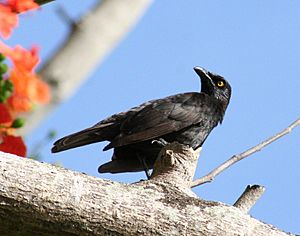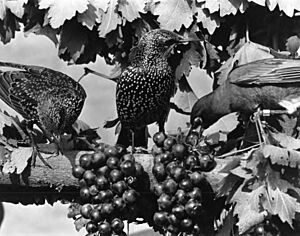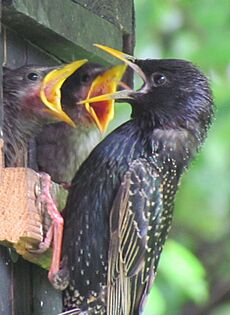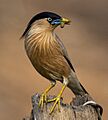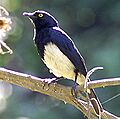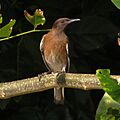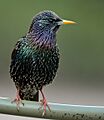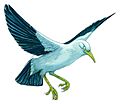Starling facts for kids
Quick facts for kids Starlings |
|
|---|---|
 |
|
| Hildebrandt's starling (Lamprotornis hildebrandti) |
|
| Scientific classification |
|
| Kingdom: | Animalia |
| Phylum: | Chordata |
| Class: | Aves |
| Order: | Passeriformes |
| Suborder: | Passeri |
| Family: | Sturnidae Rafinesque, 1815 |
| Genera | |
|
Nearly 30, see text. |
|
Starlings are small to medium-sized birds that can be found all over the world. They belong to a family of birds called Sturnidae. Many starlings have dark, shiny feathers that shimmer with different colors in the light. They are also famous for two things: their amazing ability to copy sounds and their incredible flying formations, called murmurations.
The starling family has 128 different species. Many of the larger species in Asia are called mynas, and many in Africa are known as glossy starlings because their feathers are so shiny. Starlings originally lived in Europe, Asia, and Africa. People later brought some species to North America, Australia, and New Zealand. The most familiar species for many people is the common starling.
Starlings are strong flyers and very social birds that live in groups. They like open areas and eat insects and fruit. Most starlings build their nests in holes and lay blue or white eggs.
Contents
What Do Starlings Look Like?
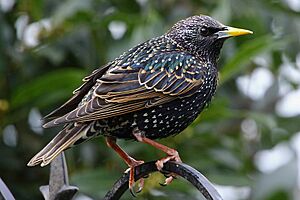
Starlings come in different sizes. The smallest is about 15 cm long, while the largest can be up to 36 cm. Many starlings have beautiful, glossy feathers that shine with colors like purple, green, and blue. This shininess is called iridescence. It's not caused by paint-like colors (pigments) in the feathers. Instead, the special structure of the feathers reflects light in a way that creates shimmering colors, like a soap bubble or the back of a CD.
Some Asian starlings have cool feathers on their heads that they can raise, called crests. In most starling species, male and female birds look very similar.
Where Do Starlings Live?
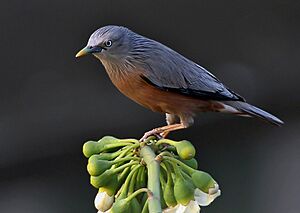
Starlings are found in many different places, from cold regions near the Arctic to warm tropical areas. They originally lived in Europe, Asia, and Africa. They are not naturally found in North or South America.
However, some species, like the common starling, were brought to new places by people. In the late 1800s, groups in North America released European starlings. These birds adapted very well and spread across the continent. When a species is brought to a new place and starts to cause problems for the local wildlife, it is called an invasive species. Starlings can compete with native birds for food and nesting spots.
Starlings are very adaptable. They can live in forests, open grasslands, and even in cities and towns alongside people. Some types of starlings migrate, meaning they fly to different places for the winter and summer.
Starling Behavior
Starlings are very social birds and love to be in groups. They often gather in large numbers, especially when it's time to rest for the night.
Amazing Fliers: The Murmuration
One of the most spectacular things starlings do is fly in huge, swirling flocks called murmurations. Thousands of birds move together as if they are one giant, shape-shifting cloud in the sky. They twist, turn, and dive without a single leader.
Scientists have studied how they do this without crashing into each other. They found that each bird pays close attention to its seven closest neighbors. By matching the speed and direction of the birds right next to it, the entire flock can move in a coordinated way. This amazing teamwork helps protect them from predators like falcons, which can get confused by the massive, moving flock. In Denmark, these flocks can be so big they are called Sort sol, which means "Black Sun."
Talented Talkers
Starlings are excellent mimics. This means they can copy the sounds they hear around them. They can imitate the calls of 15 to 20 other types of birds. They can also copy sounds from our world, like car alarms or human speech. Each starling has a unique call, which helps them recognize each other.
What Do Starlings Eat?
Starlings are not picky eaters. Their diet mostly consists of insects and fruits. Because they eat a lot of fruit, they are important for spreading seeds. When a starling eats a fruit and then flies to a new spot, it helps new plants grow there.
They have a clever way of finding insects hiding in the ground. They will poke their beak into the soil and then force it open. This technique, called "open-bill probing," creates a hole that reveals tasty grubs and other bugs.
Sometimes, starlings eat fruit that is so ripe it has started to ferment. Fermented fruit contains small amounts of natural alcohol. Starlings' bodies are very good at breaking down this alcohol quickly, so it doesn't harm them. Some starlings also drink nectar from flowers.
Types of Starlings
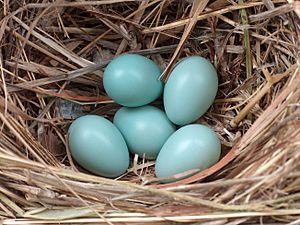
The starling family is very large, with about 128 different species. While many starlings are dark and glossy, others are very colorful.
Some of the most well-known types include:
- Common starling (Sturnus vulgaris): This is the starling most people in Europe and North America are familiar with.
- Mynas: Many of the larger Asian species are called mynas. Some, like the Common Hill Myna, are known for being able to copy human speech.
- Glossy Starlings: Many African species are called glossy starlings because of their super shiny, metallic-looking feathers. The Superb starling and Hildebrandt's starling are famous for their bright, beautiful colors.
- Bali myna: This is a beautiful, bright white starling from Bali, Indonesia. It is critically endangered, which means it is very rare and in danger of disappearing forever.
Gallery of Starlings
-
Common myna (A. tristis)
-
Golden-crested myna (A. coronatus)
-
Metallic starling (A. metallica)
-
Sulawesi myna (B. celebensis)
-
Fiery-browed myna (E. erythrophris)
-
Apo myna (G. miranda)
-
Indian pied myna (G. contra)
-
Bali myna (L. rothschildi)
-
Yellow-faced myna (M. dumontii)
-
Coleto (S. calvus)
-
White-cheeked starling (S. cineraceus)
-
Brahminy starling (S. pagodarum)
-
White-faced starling (S. albofrontatus)
-
Hoopoe starling (†F. varius)
-
Rodrigues starling (†N. rodericanus)
-
Violet-backed starling (C. leucogaster)
-
Wattled starling (C. cinerea)
-
White-collared starling (G. torquata)
-
Greater blue-eared starling (L. chalybaeus)
-
Red-winged starling (O. morio)
-
Rosy starling (P. roseus)
-
Common starling (S. vulgaris)
See also
 In Spanish: Estúrnidos para niños
In Spanish: Estúrnidos para niños


